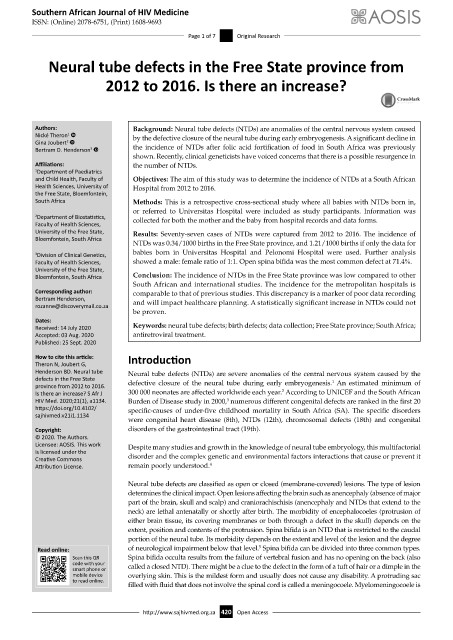Page 428 - HIVMED_v21_i1.indb
P. 428
Southern African Journal of HIV Medicine
ISSN: (Online) 2078-6751, (Print) 1608-9693
Page 1 of 7 Original Research
Neural tube defects in the Free State province from
2012 to 2016. Is there an increase?
Authors: Background: Neural tube defects (NTDs) are anomalies of the central nervous system caused
Nické Theron by the defective closure of the neural tube during early embryogenesis. A significant decline in
1
Gina Joubert 2
Bertram D. Henderson the incidence of NTDs after folic acid fortification of food in South Africa was previously
3
shown. Recently, clinical geneticists have voiced concerns that there is a possible resurgence in
Affiliations: the number of NTDs.
1 Department of Paediatrics
and Child Health, Faculty of Objectives: The aim of this study was to determine the incidence of NTDs at a South African
Health Sciences, University of Hospital from 2012 to 2016.
the Free State, Bloemfontein,
South Africa Methods: This is a retrospective cross-sectional study where all babies with NTDs born in,
or referred to Universitas Hospital were included as study participants. Information was
2 Department of Biostatistics,
Faculty of Health Sciences, collected for both the mother and the baby from hospital records and data forms.
University of the Free State, Results: Seventy-seven cases of NTDs were captured from 2012 to 2016. The incidence of
Bloemfontein, South Africa
NTDs was 0.34/1000 births in the Free State province, and 1.21/1000 births if only the data for
3 Division of Clinical Genetics, babies born in Universitas Hospital and Pelonomi Hospital were used. Further analysis
Faculty of Health Sciences, showed a male: female ratio of 1:1. Open spina bifida was the most common defect at 71.4%.
University of the Free State,
Bloemfontein, South Africa Conclusion: The incidence of NTDs in the Free State province was low compared to other
South African and international studies. The incidence for the metropolitan hospitals is
Corresponding author: comparable to that of previous studies. This discrepancy is a marker of poor data recording
Bertram Henderson, and will impact healthcare planning. A statistically significant increase in NTDs could not
[email protected]
be proven.
Dates:
Received: 14 July 2020 Keywords: neural tube defects; birth defects; data collection; Free State province; South Africa;
Accepted: 03 Aug. 2020 antiretroviral treatment.
Published: 25 Sept. 2020
How to cite this article: Introduction
Theron N, Joubert G,
Henderson BD. Neural tube Neural tube defects (NTDs) are severe anomalies of the central nervous system caused by the
defects in the Free State defective closure of the neural tube during early embryogenesis. An estimated minimum of
1
province from 2012 to 2016.
2
Is there an increase? S Afr J 300 000 neonates are affected worldwide each year. According to UNICEF and the South African
HIV Med. 2020;21(1), a1134. Burden of Disease study in 2000, numerous different congenital defects are ranked in the first 20
3
https://doi.org/10.4102/ specific-causes of under-five childhood mortality in South Africa (SA). The specific disorders
sajhivmed.v21i1.1134
were congenital heart disease (8th), NTDs (12th), chromosomal defects (18th) and congenital
Copyright: disorders of the gastrointestinal tract (19th).
© 2020. The Authors.
Licensee: AOSIS. This work Despite many studies and growth in the knowledge of neural tube embryology, this multifactorial
is licensed under the
Creative Commons disorder and the complex genetic and environmental factors interactions that cause or prevent it
Attribution License. remain poorly understood. 4
Neural tube defects are classified as open or closed (membrane-covered) lesions. The type of lesion
determines the clinical impact. Open lesions affecting the brain such as anencephaly (absence of major
part of the brain, skull and scalp) and craniorachischisis (anencephaly and NTDs that extend to the
neck) are lethal antenatally or shortly after birth. The morbidity of encephalocoeles (protrusion of
either brain tissue, its covering membranes or both through a defect in the skull) depends on the
extent, position and contents of the protrusion. Spina bifida is an NTD that is restricted to the caudal
portion of the neural tube. Its morbidity depends on the extent and level of the lesion and the degree
5
Read online: of neurological impairment below that level. Spina bifida can be divided into three common types.
Read online:
Scan this QR Spina bifida occulta results from the failure of vertebral fusion and has no opening on the back (also
Scan this QR
code with your
code with your called a closed NTD). There might be a clue to the defect in the form of a tuft of hair or a dimple in the
smart phone or
smart phone or
mobile device
mobile device overlying skin. This is the mildest form and usually does not cause any disability. A protruding sac
to read online.
to read online.
filled with fluid that does not involve the spinal cord is called a meningocoele. Myelomeningocoele is
http://www.sajhivmed.org.za 420 Open Access

